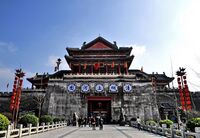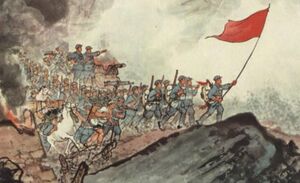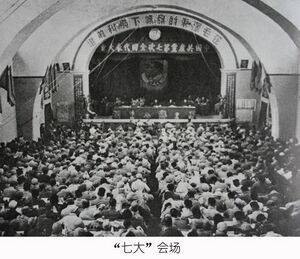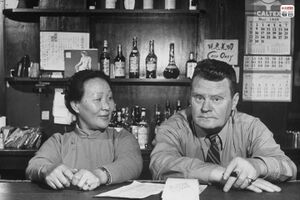Yanbad: Difference between revisions
No edit summary |
|||
| (64 intermediate revisions by the same user not shown) | |||
| Line 2: | Line 2: | ||
{{Infobox country | {{Infobox country | ||
|conventional_long_name = The People's Republic of Yanbad | |conventional_long_name = The People's Republic of Yanbad | ||
| native_name = | | native_name = 人民共和国秦 | ||
|common_name = Yanbad | |common_name = Yanbad | ||
|image_flag = YanbadFlag.jpg | |image_flag = YanbadFlag.jpg | ||
| Line 12: | Line 12: | ||
|symbol_type = National Coat of Arms | |symbol_type = National Coat of Arms | ||
|national_motto = ''Dare to think, dare to act, dare to speak'' | |national_motto = ''Dare to think, dare to act, dare to speak'' | ||
|national_anthem = | |national_anthem = 国际华人合唱团<br> <small>''The Internationale''</small> <br> [[File:MediaPlayer.png|link=https://www.youtube.com/watch?v=X9pGTOlhRvs|200px]] | ||
|other_symbol_type = | |other_symbol_type = | ||
|other_symbol = | |other_symbol = | ||
| Line 29: | Line 29: | ||
|official_languages = Standard Chinese | |official_languages = Standard Chinese | ||
|national_languages = | |national_languages = | ||
|regional_languages = | |regional_languages = Mongolian,Vietnamese | ||
|languages_type = <!--Use to specify a further type of language, if not official, national or regional--> | |languages_type = <!--Use to specify a further type of language, if not official, national or regional--> | ||
|languages = <!--Languages of the further type--> | |languages = <!--Languages of the further type--> | ||
| Line 36: | Line 36: | ||
|languages2 = <!--Languages of this second further type--> | |languages2 = <!--Languages of this second further type--> | ||
|languages2_sub = <!--Is the second alternative type of languages a sub-item of the previous non-sub type? ("yes" or "no")--> | |languages2_sub = <!--Is the second alternative type of languages a sub-item of the previous non-sub type? ("yes" or "no")--> | ||
|ethnic_groups = | |ethnic_groups = 82.0% Han<br>5.0% Kinh<br>3.0% Manchu<br>3.0% Turkic<br>2.0% Mongol<br>1.0% Jingpo<br> 1.0% Kadai<br>1.0% Phu La<br>1.0%Yao<br> 1.0% Zhuang | ||
|ethnic_groups_year = 2017 | |ethnic_groups_year = 2017 | ||
|demonym = Yanbadi | |demonym = Yanbadi | ||
|government_type = Unitary one - party socialist republic | |government_type = Unitary one - party socialist republic | ||
|leader_title1 = | |leader_title1 = Prime Minister | ||
|leader_name1 = | |leader_name1 = Yi Qianfeng | ||
|leader_title2 = | |leader_title2 = Party Leader | ||
|leader_name2 = | |leader_name2 = Yi Qianfeng | ||
|leader_title3 = Congress Head Chair | |leader_title3 = Congress Head Chair | ||
|leader_name3 = Enter Name | |leader_name3 = Enter Name | ||
| Line 115: | Line 115: | ||
|footnotes = <!--For any generic non-numbered footnotes--> | |footnotes = <!--For any generic non-numbered footnotes--> | ||
}} | }} | ||
The People's Republic of [[Yanbad]], commonly referred to as just Yanbad , is an unitary one-party socialist republic | The People's Republic of [[Yanbad]], commonly referred to as just Yanbad , is an unitary one-party socialist republic. It is a medium-sized country with a population of around 100 million people, all of which live in the country's [[ten provinces]]. Yanbad borders. | ||
| Line 152: | Line 152: | ||
===Education=== | ===Education=== | ||
<!--{{Main|Education in Yanbad}}--> | <!--{{Main|Education in Yanbad}}--> | ||
Primary education is free throughout the People's Republic for all children regardless of socio-economic status. Upon completing 12th grade and earning their Primary School Diploma students may take tests in order to qualify for higher education. There are four levels of degrees that students can earn after their primary school diploma: [https://en.wikipedia.org/wiki/Associate_degree Associate Degree], [https://en.wikipedia.org/wiki/Bachelor%27s_degree#United_States Bachelor's Degree],[https://en.wikipedia.org/wiki/Master%27s_degree Master's Degree], and a [https://en.wikipedia.org/wiki/Doctor_of_Philosophy PhD (Doctorate of Philosophy)] | |||
==History== | ==History== | ||
| Line 162: | Line 163: | ||
===Yan Yanbad=== | ===Yan Yanbad=== | ||
[[File:Yan.Palace.Not.Qin.jpg|200px|thumb|left|The Hengdai Palace in the Yan capital of Ziyang.]] | |||
The Yan Dynasty ruled over modern day eastern Yanbad from 230 BCE to 200 BCE. It was the first dynasty of Imperial Yanbad and the first to unify the eastern heartland of Modern Yanbad. The founder of the dynasty Yan Bao unified the empire in 230 BCE and ruled it until his death in 222 BCE. Yan Guang (230 BCE - 209 BCE) ruled over the empire and finished his father's work of building the capital of Ziyang and the palace of Hengdai. The last Yan Emperor, Yan Ang (209 BCE - 200 BCE) died without an heir which caused the throne to pass to the Tay family which were related to the Yan through marriage. Historians believe that the region came to be known as "Yanbad" due to a translation mistake of the first dynasty's name. | The Yan Dynasty ruled over modern day eastern Yanbad from 230 BCE to 200 BCE. It was the first dynasty of Imperial Yanbad and the first to unify the eastern heartland of Modern Yanbad. The founder of the dynasty Yan Bao unified the empire in 230 BCE and ruled it until his death in 222 BCE. Yan Guang (230 BCE - 209 BCE) ruled over the empire and finished his father's work of building the capital of Ziyang and the palace of Hengdai. The last Yan Emperor, Yan Ang (209 BCE - 200 BCE) died without an heir which caused the throne to pass to the Tay family which were related to the Yan through marriage. Historians believe that the region came to be known as "Yanbad" due to a translation mistake of the first dynasty's name. | ||
===Tay Yanbad=== | ===Tay Yanbad=== | ||
The Tay dynasty oversaw the political and cultural consolidation of the early Yanbad state. | |||
The Tay Dynasty ruled over modern day eastern Yanbad from 200 BCE to 150 CE. It was the second dynasty of Imperial Yanbad. The founder of the dynasty Tay Zhu was married to Yan Ang's niece and as a result inherited the empire from him in 200 BCE. Scholars believe in order to legitimize his authority, Tay Zhu developed the concept of Ruling at the Behest of the Ancestors. (make page for this) Tay Zhu ruled from 200 BCE to 185 BCE, upon Zhu's death the throne went to his son Tey Zhu | |||
===Hong Yanbad=== | ===Hong Yanbad=== | ||
[[File:Battle of Bach Dang (1288).jpg|300px|thumb|right|The Battle of the Soupi Bend, the pivotal battle in the Wars of the Rivers.]] | |||
The Hong Dynasty took control of Yanbad after their victory in the War for the Rivers | The Hong Dynasty took control of Yanbad after their victory in the War for the Rivers | ||
[https://iiwiki.us/wiki/National_Animal_Of_Yanbad The Battle of the Soupi Bend] | |||
===Lui Yanbad=== | ===Lui Yanbad=== | ||
Minh rule | |||
===Taizong Yanbad=== | ===Taizong Yanbad=== | ||
Han Rule | |||
===Zhu Yanbad=== | ===Zhu Yanbad=== | ||
Song (Han) Rule | |||
===Kaidu Yanbad=== | ===Kaidu Yanbad=== | ||
Mongol Rule | |||
===Hongwu Yanbad=== | ===Hongwu Yanbad=== | ||
Ming (Han) Rule | |||
===Fulen Yanbad=== | ===Fulen Yanbad=== | ||
Manchu Rule | |||
===Decline of the Imperial System=== | ===Decline of the Imperial System=== | ||
===The People's Republic of Yanbad=== | ===The People's Republic of Yanbad=== | ||
===World | [[File:The.Peoples.Army.of.Yanbad.jpg|300px|thumb|left|A poster from the People's Army of Yanbad.]] | ||
===World Wars=== | |||
===Cold War=== | ===Cold War=== | ||
===Modern era=== | ===Modern era=== | ||
| Line 193: | Line 208: | ||
===Administrative | ===Administrative Provinces=== | ||
The People's Republic of Yanbad is divided in to [[Provinces of Yanbad| | The People's Republic of Yanbad is divided in to [[Provinces of Yanbad|ten provinces]], each of which is divided in to a varying number of administrative counties. | ||
{| class="wikitable" | |||
!width=50x|Province Flag | |||
! Province Name | |||
! Province Capital | |||
! Province Motto | |||
! Population | |||
|- | |||
| [[File: PRYN_NEWS.jpg |100px]] | |||
| Tsudo ~ Han | |||
| Ziyang | |||
| A bright past, an even brighter future | |||
| | |||
|- | |||
| [[File:|50px]] | |||
| Mongzhou ~ Han | |||
| Lainning | |||
| The energy of the old generation inspires the new | |||
| | |||
|- | |||
| [[File:|50px]] | |||
| Rouqiang ~ Han | |||
| Ganzhu | |||
| Let a million flowers bloom | |||
| | |||
|- | |||
| [[File:|50px]] | |||
| Former Western Colonial Possession ~ Han | |||
| | |||
| | |||
| | |||
|- | |||
| [[File:|50px]] | |||
| Danoi ~ Kinh | |||
| Tien Da | |||
| Fortune favors the bold | |||
| | |||
|- | |||
| [[File:|50px]] | |||
| Kampala ~ Phu La & Jingpo | |||
| Wunpawng | |||
| The gateway to the exotic | |||
| | |||
|- | |||
| [[File:|50px]] | |||
| Bukadan Feng ~ Yao & Kadai | |||
| Lashi | |||
| Here we stand | |||
| | |||
|- | |||
| [[File:|50px]] | |||
| Nagachu ~ Manchu | |||
| Liaoyang | |||
| We lead the way | |||
| | |||
|- | |||
| [[File:|50px]] | |||
| Mongolian ~ Toghus | |||
| Erdenet | |||
| From the steppe,to the sea, nothing but beauty | |||
| | |||
|- | |||
| [[File:|50px]] | |||
| Turkic ~ Teljut | |||
| Manzimir | |||
| One faith, one people | |||
| | |||
|} | |||
==Politics== | ==Politics== | ||
===The Communist Party of Yanbad=== | ===The Communist Party of Yanbad=== | ||
The Communist Party of Yanbad was founded after the {{wp|Communist Manifesto|Communist Manifesto}} had been translated into {{wp|Chinese language|Standard Chinese}} and spread among educated youth in the treaty ports throughout Yanbad's coastline. | |||
[[File:National.party.meeting.jpg|300px|thumb|left|One of the first meetings of the Communist Party of Yanbad, mid 20th century]] | |||
The current leader of the Communist Party of Yanbad is Prime Minister Yi Qianfeng | |||
===National People's Congress=== | ===National People's Congress=== | ||
===Communist Party of Yanbad's Politburo Standing Committee=== | ===Communist Party of Yanbad's Politburo Standing Committee=== | ||
The Politburo Standing Committee serves as a cabinet for the Prime Minister. Members are appointed by the Prime Minister and symbolically voted in by the National People's Congress. The practice of the Politburo serving as advisers to the Prime Minister dates back to the early days of the Communist Revolution and numerous foreign threats the Communist Party faced in its early days. As a result of the dire situation and the need to make fast appointments, the National People's Congress traditionally acquiesces to these appointments. The following lists the Committees in order of their creation: Committee of the People's Defense, Committee of the People's Agriculture, Committee of the People's Treasury, Committee of the People's State , Committee of the People's Justice , Committee of People's Commerce, Committee of the People's Labor , Committee of the People's Health , Committee of the People's Housing , Committee of the People's Transportation ,Committee of the People's Energy , Committee of the People's Education , Committee of the People's Veterans. | |||
The newest position, Secretary of Youth Engagement was created on October 14, 2019 via executive directive and Ai Naal was appointed for the position. | |||
{{Main|Party Leaders of Yanbad}} | {{Main|Party Leaders of Yanbad}} | ||
| Line 209: | Line 297: | ||
===Foreign relations=== | ===Foreign relations=== | ||
[[File:Yanbadi.and.unkown.westerner.jpg|300px|thumb|right|An Yanbadi citizen meeting with an unkown westerner in the 1950's]] | |||
===Military=== | ===Military=== | ||
| Line 237: | Line 325: | ||
==Culture== | ==Culture== | ||
===National Animal=== | ===National Animal=== | ||
[[File:Leatherback sea turtle Tinglar, USVI (5839996547).jpg|300px|thumb|left|The Leatherback Sea Turtle]] | |||
The national animal of the People's Republic of Yanbad is the Leatherback Sea Turtle due in part to the Hong family's victory over the Tay at the Soupi Bend during the Wars of the Rivers. [https://iiwiki.us/wiki/National_Animal_Of_Yanbad Leatherback Sea Turtle] | |||
===Art=== | |||
===Philosophy=== | |||
The | The official philosophy of the People's Republic is the {{wp|Communist Manifesto|Communist Manifesto}} | ||
===Literature=== | ===Literature=== | ||
One of the biggest book series in Yanbad is the Ballad of the Rivers which is a high fantasy series that was inspired by the Wars of the Rivers that were fought between Tay and Hong families. The books have spawned multiple spin-offs, video games, and even an award winning show! The television adaption of the series is named after the first book, A Frolic of Rivers. | One of the biggest book series in Yanbad is the Ballad of the Rivers which is a high fantasy series that was inspired by the Wars of the Rivers that were fought between Tay and Hong families. The books have spawned multiple spin-offs, video games, and even an award winning show! The television adaption of the series is named after the first book, A Frolic of Rivers. | ||
A Frolic of Rivers - | A Frolic of Rivers - | ||
[[File:Japanese.asoiaf.arya.full (2).jpg|150px|thumb|left| A Frolic of Rivers]] | |||
The first book in the main series shocked fantasy fans with the unexpected execution of the Li family patriarch Li Hed, by Zhang Jo. The execution ignited the conflict between the Zhang and Li families, thus dragging all of the powerful families of Yessos into a dynastic conflict for the Rama Throne. | The first book in the main series shocked fantasy fans with the unexpected execution of the Li family patriarch Li Hed, by Zhang Jo. The execution ignited the conflict between the Zhang and Li families, thus dragging all of the powerful families of Yessos into a dynastic conflict for the Rama Throne. | ||
Disharmony of Ramas - | Disharmony of Ramas - | ||
[[File:Japanese.asoiaf.daenerys.japanese (2).jpg|150px|thumb|right| Disharmony of Ramas]] | |||
The second book continues the conflict between the Li and Zhang but expands the characters involved beyond the two major families. With multiple claimants as the “True Rama” war erupts throughout the kingdom, all while an ancient claimant to the throne gathers strength in the east, Tasa Dane. | The second book continues the conflict between the Li and Zhang but expands the characters involved beyond the two major families. With multiple claimants as the “True Rama” war erupts throughout the kingdom, all while an ancient claimant to the throne gathers strength in the east, Tasa Dane. | ||
Monsoon of Glaives - | Monsoon of Glaives - | ||
[[File:Japanese.asoiaf.jon.snow.full (2).jpg|150px|thumb|left| Monsoon of Glaives]] | |||
The third and final book details the climactic battle between the Li and Zhang. One of the main characters Li Jen who is thought to be an illegitimate bastard of Li Hed is revealed to be the actual heir to the Rama Throne since he is the eldest living male heir of the Tasa family. | The third and final book details the climactic battle between the Li and Zhang. One of the main characters Li Jen who is thought to be an illegitimate bastard of Li Hed is revealed to be the actual heir to the Rama Throne since he is the eldest living male heir of the Tasa family. | ||
| Line 265: | Line 353: | ||
{| class="wikitable" | {| class="wikitable" | ||
!width= | !width=50x|Logo | ||
! Television channel | ! Television channel | ||
! Public / Private | ! Public / Private | ||
| Line 271: | Line 359: | ||
! Audience share | ! Audience share | ||
|- | |- | ||
| [[File:| | | [[File: PRYN_NEWS.jpg |100px]] | ||
| Yanbad News | | People's Republic of Yanbad News (PRYN) | ||
| Public | | Public | ||
| news, state programming | | news, state programming | ||
| Line 278: | Line 366: | ||
|- | |- | ||
| [[File:|50px]] | | [[File:|50px]] | ||
| | | International News | ||
| | | Private | ||
| | | foreign news broadcasts and select programming | ||
| | | | ||
|- | |- | ||
| Line 294: | Line 382: | ||
| | | | ||
| | | | ||
|- | |- | ||
|} | |} | ||
===Sport=== | ===Sport=== | ||
| Line 329: | Line 409: | ||
{{Template reference list}} | {{Template reference list}} | ||
{{Yanbad topics}} | {{Yanbad topics}} | ||
[[Category:Yanbad]] | [[Category:Yanbad]] | ||
Latest revision as of 03:22, 5 June 2020
This article is incomplete because it is pending further input from participants, or it is a work-in-progress by one author. Please comment on this article's talk page to share your input, comments and questions. Note: To contribute to this article, you may need to seek help from the author(s) of this page. |
The People's Republic of Yanbad 人民共和国秦 | |
|---|---|
| Motto: Dare to think, dare to act, dare to speak | |
| Anthem: 国际华人合唱团 The Internationale | |
| Capital | Ganzhu |
| Official languages | Standard Chinese |
| Recognised regional languages | Mongolian,Vietnamese |
| Ethnic groups (2017) | 82.0% Han 5.0% Kinh 3.0% Manchu 3.0% Turkic 2.0% Mongol 1.0% Jingpo 1.0% Kadai 1.0% Phu La 1.0%Yao 1.0% Zhuang |
| Demonym(s) | Yanbadi |
| Government | Unitary one - party socialist republic |
• Prime Minister | Yi Qianfeng |
• Party Leader | Yi Qianfeng |
• Congress Head Chair | Enter Name |
| Legislature | National People's Congress |
| work in progress | |
| Area | |
• Total | [convert: invalid number] |
• Water (%) | work in progress |
| Population | |
• wip estimate | wip |
• Density | [convert: invalid number] |
| GDP (PPP) | wip estimate |
• Total | wip |
• Per capita | wip |
| HDI | 0.949 very high |
| Currency | Yanbadi Baht (YAB) |
| Time zone | UTC+0 (wip) |
• Summer (DST) | UTC+1 (Observed) |
| Date format | dd-mm-yyyy |
| Driving side | the right |
| Calling code | +611 |
| ISO 3166 code | YAN |
| Internet TLD | .yan |
The People's Republic of Yanbad, commonly referred to as just Yanbad , is an unitary one-party socialist republic. It is a medium-sized country with a population of around 100 million people, all of which live in the country's ten provinces. Yanbad borders.
Etymology
Historians believe that the region came to be known as "Yanbad" due to a translation mistake of the first dynasty's name which was Yan.
Demographics
Language
Yanbad's national language is Standard Chinese. Schools nationwide teach the language and use it for instructions. The Standard Chinese language is the lingua franca for the People's Republic and is spoken throughout the country. Although in different regions there are different dialects of the language. In the Southern provinces of Yanbad where the Kinh, Phu La, and the Jingpo people predominately live the Vietnamese language is often used in place of Standard Chinese. Whereas the Mongolian language is spoken in the Northern provinces where the Mongolian people live.
Religion
Freedom of religion is officially provided for in the Constitution of the People's Republic of Yanbad. The government does not interfere with any religious beliefs or lack of, but is generally irreligious. Many Yanbadi citizens define themselves as non-religious or atheist , although there are many religious minorities throughout the country who are allowed to express their religion freely.
Health
Healthcare in Yanbad consists of both public and private health insurance. Approximately 90% of Yanbadi citizens have at least basic health insurance due in part to the benefits workers enjoy through the Iron Basket Initiative that the Communist Party of Yanbad's Politburo Standing Committee enacted after the formation of the People's Republic.
Education
Primary education is free throughout the People's Republic for all children regardless of socio-economic status. Upon completing 12th grade and earning their Primary School Diploma students may take tests in order to qualify for higher education. There are four levels of degrees that students can earn after their primary school diploma: Associate Degree, Bachelor's Degree,Master's Degree, and a PhD (Doctorate of Philosophy)
History
Prehistoric Yanbad
Historians and scholars refer to Prehistoric Yanbad as the era of The Five Sovereigns and Ten Emperors. Much isn’t known of this time period since there is a lack of primary sources written during the time period. Scholars throughout the subsequent dynasties had written about this time period and referenced them in their own documents. As a result all of the written accounts related to this era are questionable at best. Most of the knowledge from this time period was discovered via archaeological digs and studies of material culture. The leading consensus is that Prehistoric Yanbadis buried their dead with supplies for the afterlife. Items such as food, weapons, clothing, and pottery have been discovered in many ancient tombs.
Background on Different Dynastic Eras
One might assume that throughout the Imperial Era the various dynasties all rose and fell through violent means. While there are instances of a dynasty violently overthrowing another there are also examples of dynasties taking control through more peaceful means such as one family dying out.
Yan Yanbad
The Yan Dynasty ruled over modern day eastern Yanbad from 230 BCE to 200 BCE. It was the first dynasty of Imperial Yanbad and the first to unify the eastern heartland of Modern Yanbad. The founder of the dynasty Yan Bao unified the empire in 230 BCE and ruled it until his death in 222 BCE. Yan Guang (230 BCE - 209 BCE) ruled over the empire and finished his father's work of building the capital of Ziyang and the palace of Hengdai. The last Yan Emperor, Yan Ang (209 BCE - 200 BCE) died without an heir which caused the throne to pass to the Tay family which were related to the Yan through marriage. Historians believe that the region came to be known as "Yanbad" due to a translation mistake of the first dynasty's name.
Tay Yanbad
The Tay dynasty oversaw the political and cultural consolidation of the early Yanbad state. The Tay Dynasty ruled over modern day eastern Yanbad from 200 BCE to 150 CE. It was the second dynasty of Imperial Yanbad. The founder of the dynasty Tay Zhu was married to Yan Ang's niece and as a result inherited the empire from him in 200 BCE. Scholars believe in order to legitimize his authority, Tay Zhu developed the concept of Ruling at the Behest of the Ancestors. (make page for this) Tay Zhu ruled from 200 BCE to 185 BCE, upon Zhu's death the throne went to his son Tey Zhu
Hong Yanbad
The Hong Dynasty took control of Yanbad after their victory in the War for the Rivers The Battle of the Soupi Bend
Lui Yanbad
Minh rule
Taizong Yanbad
Han Rule
Zhu Yanbad
Song (Han) Rule
Kaidu Yanbad
Mongol Rule
Hongwu Yanbad
Ming (Han) Rule
Fulen Yanbad
Manchu Rule
Decline of the Imperial System
The People's Republic of Yanbad
World Wars
Cold War
Modern era
Geography
Climate
Administrative Provinces
The People's Republic of Yanbad is divided in to ten provinces, each of which is divided in to a varying number of administrative counties.
Politics
The Communist Party of Yanbad
The Communist Party of Yanbad was founded after the Communist Manifesto had been translated into Standard Chinese and spread among educated youth in the treaty ports throughout Yanbad's coastline.
The current leader of the Communist Party of Yanbad is Prime Minister Yi Qianfeng
National People's Congress
Communist Party of Yanbad's Politburo Standing Committee
The Politburo Standing Committee serves as a cabinet for the Prime Minister. Members are appointed by the Prime Minister and symbolically voted in by the National People's Congress. The practice of the Politburo serving as advisers to the Prime Minister dates back to the early days of the Communist Revolution and numerous foreign threats the Communist Party faced in its early days. As a result of the dire situation and the need to make fast appointments, the National People's Congress traditionally acquiesces to these appointments. The following lists the Committees in order of their creation: Committee of the People's Defense, Committee of the People's Agriculture, Committee of the People's Treasury, Committee of the People's State , Committee of the People's Justice , Committee of People's Commerce, Committee of the People's Labor , Committee of the People's Health , Committee of the People's Housing , Committee of the People's Transportation ,Committee of the People's Energy , Committee of the People's Education , Committee of the People's Veterans.
The newest position, Secretary of Youth Engagement was created on October 14, 2019 via executive directive and Ai Naal was appointed for the position.
Local politics
Foreign relations
Military
Economy
Transport and infrastructure
Energy
Culture
National Animal
The national animal of the People's Republic of Yanbad is the Leatherback Sea Turtle due in part to the Hong family's victory over the Tay at the Soupi Bend during the Wars of the Rivers. Leatherback Sea Turtle
Art
Philosophy
The official philosophy of the People's Republic is the Communist Manifesto
Literature
One of the biggest book series in Yanbad is the Ballad of the Rivers which is a high fantasy series that was inspired by the Wars of the Rivers that were fought between Tay and Hong families. The books have spawned multiple spin-offs, video games, and even an award winning show! The television adaption of the series is named after the first book, A Frolic of Rivers.
A Frolic of Rivers -
The first book in the main series shocked fantasy fans with the unexpected execution of the Li family patriarch Li Hed, by Zhang Jo. The execution ignited the conflict between the Zhang and Li families, thus dragging all of the powerful families of Yessos into a dynastic conflict for the Rama Throne.
Disharmony of Ramas -
The second book continues the conflict between the Li and Zhang but expands the characters involved beyond the two major families. With multiple claimants as the “True Rama” war erupts throughout the kingdom, all while an ancient claimant to the throne gathers strength in the east, Tasa Dane.
Monsoon of Glaives -
The third and final book details the climactic battle between the Li and Zhang. One of the main characters Li Jen who is thought to be an illegitimate bastard of Li Hed is revealed to be the actual heir to the Rama Throne since he is the eldest living male heir of the Tasa family.









